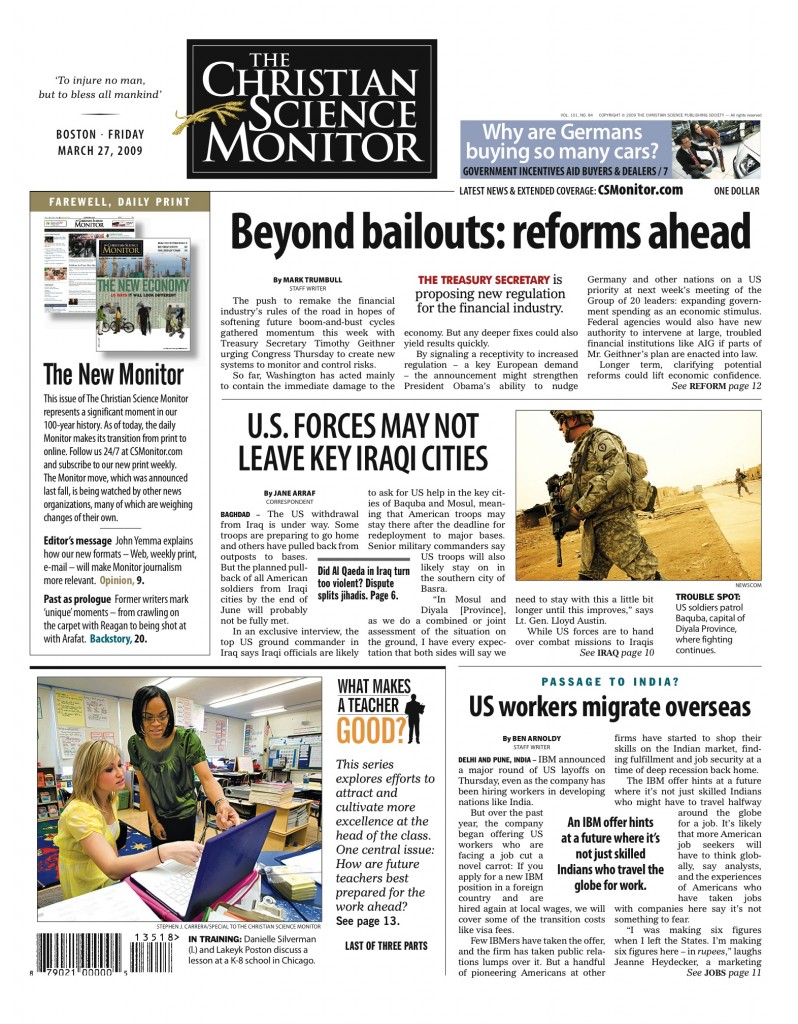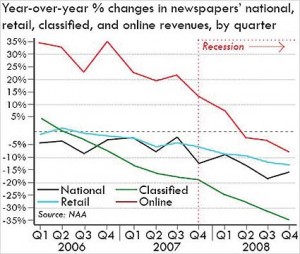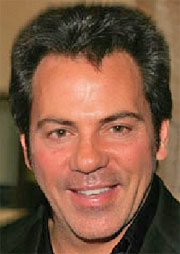 Amid all the hand-wringing about the lack of new-media alternatives to newspapers, the online-only Huffington Post is setting up a small investigative unit to examine the nation’s economy. The news site is collaborating with The Atlantic Philanthropies and others to launch the Huffington Post Investigative Fund with an initial budget of $1.75 million and plans to hire 10 investigative journalists who will primarily coordinate work done by freelancers. “All of us increasingly have to look at different ways to save investigative journalism,” said founder Ariana Huffington (left). She added that the fund will probably hire laid-off newspaper journalists.
Amid all the hand-wringing about the lack of new-media alternatives to newspapers, the online-only Huffington Post is setting up a small investigative unit to examine the nation’s economy. The news site is collaborating with The Atlantic Philanthropies and others to launch the Huffington Post Investigative Fund with an initial budget of $1.75 million and plans to hire 10 investigative journalists who will primarily coordinate work done by freelancers. “All of us increasingly have to look at different ways to save investigative journalism,” said founder Ariana Huffington (left). She added that the fund will probably hire laid-off newspaper journalists.
Everything the venture produces will be available free for any publication or website to publish. While the group’s initial focus will be on the economy, the founders intend to cover a wide range of topics over time. Content won’t reflect HuffPo’s left-leaning politics because the philanthropic funding requires a neutral perspective. Jay Rosen, who will advise the project, has more detail on his blog.
Critics find a hint of irony in Huffington’s journalism bailout plan. Joseph Tartakoff notes that “Some traditional media outlets have previously accused the HuffPo of stealing their content. The Chicago Reader, for instance, charged Huffington Post with ‘grand theft‘ after it reprinted one of the publication’s articles wholesale on its site.” HuffPo practices a new style of journalism with a small staff of reporters and links to other sources aggressively from its home page.
Jeff Jarvis likes the HuffPo idea and suggests that $1.75 million can go a lot farther than one might think. He evokes the “1% rule” of online communities, which is that 1% of the people create the content that the other 99% consume and discuss. “You need only a limited number of contributors to support great things in a gift economy. See: Wikipedia and NPR,” Jarvis writes.
 John Yemma would probably agree. As his publication, the Christian Science Monitor, goes Web-mostly, the editor (right) has launched a blog that he hopes will be “a place to talk about the changes in media.” In his second entry, he compares the crowd-sourced Wikipedia model to the closed Encarta and Britannica products. “General knowledge…can’t withstand an effort that was developed specifically for the Internet and that harnesses gifted amateurs,” he writes. And he issues a warning to newspapers about putting content behind a pay wall, as Britannica and Encarta did. “The Web is its own universe with its own rules,” he writes. Such new-media thinking from a veteran print journalist indicates that the Monitor experiment will be an interesting one to watch.
John Yemma would probably agree. As his publication, the Christian Science Monitor, goes Web-mostly, the editor (right) has launched a blog that he hopes will be “a place to talk about the changes in media.” In his second entry, he compares the crowd-sourced Wikipedia model to the closed Encarta and Britannica products. “General knowledge…can’t withstand an effort that was developed specifically for the Internet and that harnesses gifted amateurs,” he writes. And he issues a warning to newspapers about putting content behind a pay wall, as Britannica and Encarta did. “The Web is its own universe with its own rules,” he writes. Such new-media thinking from a veteran print journalist indicates that the Monitor experiment will be an interesting one to watch.
Debating the Value of Newspapers to Democracy
Slate’s Jack Shafer takes a dim view of the idea that newspapers are essential to democracy. Before the current crisis, he writes, people mostly complained about the lousy job newspapers did of getting the facts straight and delivering balanced coverage. Now that the medium is failing, newspapers have been “reduced to a compulsory cheat sheet for democracy. All this lovey-dovey about how essential newspapers are to civic life and the political process makes me nostalgic for the days, not all that long ago, when everybody hated them.”
Shafer points out that when Thomas Jefferson said he preferred newspapers without government to government without newspapers, he wasn’t talking about the broadsheets we know today. Newspapers in Jefferson’s time were baldly partisan and often skewed the facts to suit their views. How did people figure out the truth when each journal had its own version of the truth? They triangulated, they checked other sources and they figured it out. This worked okay up until about 50 years ago, when newspapers decided to become the arbiters of truth. That’s convenient, but it doesn’t mean we can’t go back to a form that the founding fathers believed was essential to democracy.
The idea that many small contributions can out-produce a few big ones is nicely articulated by Timothy Lee on TechDirt. In order to understand how journalism can be reinvented, you need to discard the notion that only monolithic, vertically integrated organizations can cover the news. “The Internet makes possible a much more decentralized model, in which lots of different people, most of them volunteers, participate in the process of gathering and filtering the news,” he writes. “If millions of people each contribute small amounts of time to this kind of decentralized information-gathering, they can collectively do much of the work that used to be done by professional reporters and editors.”
If you’re geeky enough, you’ll recognize the open-source software model in this thinking. The most powerful force ever to come along in software development depends upon teams of loosely-organized developers each contributing a little bit of their time to building software that anyone can use for free. No, journalism isn’t software development, and there are certain practices of journalism that can’t be duplicated by a person sitting at a desk in India. However, Lee suggests that if the gadflies who already hang around city council meetings start reporting upon them on their blogs, then the community effect can take over to turn that amateur reportage into real journalism. You don’t need professional reporters for everything.
Jon Talton begs to differ. In an angry and resentful blog entry, he derides the idea that grass-roots efforts can ever replace the depth and credibility of what professional journalism organizations produce. Special interests, “will all have stronger voices for their agendas. Manias, rumors and groupthink will be more prevelant. In many localities, people will be particularly ill-informed about their government and major economic powers, pluralism will decrease and corruption will rise,” he writes. After that, we suppose, come the locusts.
Miscellany
Media General is cutting back again in Florida, saying there are no signs yet that the economy is picking up. Its Florida Communications Group cut 53 jobs, eliminated 12 vacant positions, closed two niche publications and added three more days of unpaid furlough to the 10 that employees were already required to take.
Back in the early days of the Web, some newspapers were criticized for withholding information from their websites until the stories had already appeared in print. Now that times have changed, the Minneapolis Star Tribune is being labeled a visionary for doing the same thing. The Strib has enjoyed good success online despite its small-market roots, so the paper is gambling that it can entice readers to become print subscribers by withholding some deep investigative reporting from the website. “The best of our deep, exclusive content will be available online later in the week, unless we have a compelling reason to post it sooner,” wrote editor Nancy Barnes in a letter to readers.
The Boston Herald laid off 12 people, or 6% of its workforce.
The Associated Press has a great list of “daily newspapers that have reduced publication days since last year.” In reality, many of the papers on the list were not technically dailies to begin with, but all publish at least five days a week. It looks like Mondays, Tuesdays and Saturdays are the most popular days to cut.




 The Houston Chronicle joins the long string of newspapers that assert their commitment to “strong watchdog journalism” while covering news of their own troubles with e.e. cummings-like simplicity. The newspaper devotes just 208 words to news that it is laying off 12% of its staff, or nearly 200 people. That’s about one word per victim. In fact, the Chronicle doesn’t even mention a body count. You have to
The Houston Chronicle joins the long string of newspapers that assert their commitment to “strong watchdog journalism” while covering news of their own troubles with e.e. cummings-like simplicity. The newspaper devotes just 208 words to news that it is laying off 12% of its staff, or nearly 200 people. That’s about one word per victim. In fact, the Chronicle doesn’t even mention a body count. You have to 





 Today is Newspaper Death Watch’s second birthday (you can
Today is Newspaper Death Watch’s second birthday (you can 



